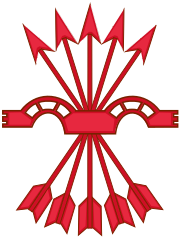You can help expand this article with text translated from the corresponding article in Spanish. (September 2024) Click [show] for important translation instructions.
|
Falange Española (FE; English: Spanish Phalanx) was a Spanish fascist political organization active from 1933 to 1934.[3]
Spanish Phalanx Falange Española | |
|---|---|
 | |
| Leader | José Antonio Primo de Rivera |
| Founded | 29 October 1933 |
| Dissolved | 15 February 1934 |
| Preceded by | Movimiento Español Sindicalista |
| Merged into | Falange Española de las JONS |
| Student wing | Sindicato Español Universitario |
| Ideology | Fascism[1] Falangism |
| Political position | Far-right[2] |
History
editThe Falange Española was created on 29 October 1933 as the successor of the Movimiento Español Sindicalista (MES), a similar organization founded earlier in 1933. (Falange translates as Phalanx in English.) The foundational meeting took place in La Comedia Theatre of Madrid and was conducted by José Antonio Primo de Rivera, Julio Ruiz de Alda and Alfonso García Valdecasas.[4] In February 1934, after poor results at the ballots in the 1933 election, José Antonio Primo de Rivera suggested a fusion of Falange Española with the Ramiro Ledesma's Juntas de Ofensiva Nacional-Sindicalista, which was approved on 15 February.[5] The Falange Española de las JONS (FE de las JONS) was subsequently formed.
The Falange's first clash with Marxist groups took place on 5 November 1933, when its militants had a rift with socialist sympathizers at a football game in Almoradí (Province of Alicante).[6]
References
edit- ^ Slaven 2018, p. 235. "On October 29, 1933, José Antonio Primo de Rivera founded a fascist political party in Madrid, Spain, called Falange Española (FE)." (...) "The FE was a distinctly fascist movement, containing “nearly all the general qualities and characteristics… of generic fascism” (Payne 1995, 261)".
- ^ Winkler 2015, p. 297.
- ^ Southworth, H. Rutledge (1939). "The Spanish Phalanx and Latin America". Foreign Affairs. 18 (1): 148–152. doi:10.2307/20028984. ISSN 0015-7120.
- ^ Box & Saz 2011, p. 374.
- ^ Albanese & Hierro 2016, p. 29.
- ^ González Calleja 2011, p. 171.
Bibliography
edit- Albanese, Matteo; Hierro, Pablo del (2016). Transnational Fascism in the Twentieth Century: Spain, Italy and the Global Neo-Fascist Network. Bloomsbury Publishing. ISBN 978-1-4725-2250-4.
- Box, Zira; Saz, Ismael (2011). "Spanish Fascism as a Political Religion (1931–1941)". Politics, Religion & Ideology. 12 (4). Taylor & Francis: 371–389. doi:10.1080/21567689.2011.624408. ISSN 2156-7697. S2CID 143784445.
- González Calleja, Eduardo (2011). Contrarrevolucionarios. Radicalización violenta de las derechas durante la Segunda República, 1931–1936. Madrid: Alianza Editorial. ISBN 978-84-206-6455-2.
- Slaven, James (2018). "The Falange Española: A Spanish Paradox". Proceedings of the 10th International RAIS Conference on Social Sciences and Humanities. 211. Atlantis Press: 235–242. doi:10.2139/ssrn.3266916. ISSN 2352-5398. Archived from the original on 2020-03-23. Retrieved 2019-06-26.
- Winkler, Heinrich August (2015) [2011]. The Age of Catastrophe: A History of the West, 1914–1945. New Haven & London: Yale University Press. ISBN 978-0300-20489-6.